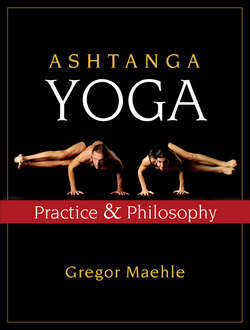Читать книгу Ashtanga Yoga - Gregor Maehle - Страница 42
Vinyasa Four (Chaturanga Dandasana)
ОглавлениеWith the beginning of the exhalation, firmly ground your hands. The hands should be shoulder width apart, the middle fingers parallel to each other and the fingers spread. As the exhalation proceeds, move the feet back with a single hop so that the body forms a straight line from the head to the feet. Land the feet so that they are hip width apart and flex them. Completing the exhalation, slowly bend the arms, lowering your body until you hover just above the floor. The elbows hug the body. Do not allow them to wander out to the sides: this stiffens the shoulders and tightens the pectoralis minor muscle. On the way down, the movement should be even, with the heart leading the way. Lift your face away from the floor to strengthen and support the back of the neck. By extending out through the heels, the coccyx drops, which lengthens the low back and positions the pelvis correctly for Upward Facing Dog, which follows. This action is balanced by an equal extension of the chest forward. The entire spine lengthens and the lower abdomen lifts away from the floor to support the lumbar spine.
PRACTICAL TIP
Stance for Beginners
As depicted in the top photo above, beginners may adopt a longer stance in Chaturanga Dandasana so that, on lowering down, the shoulders remain above the hands. Experienced students can work toward vertical forearms, tracking the elbows directly above the wrists on lowering the body. On moving into Upward Facing Dog, we aim toward positioning the shoulders above the wrists. Viewed from the side, the arms are perpendicular to the floor.
